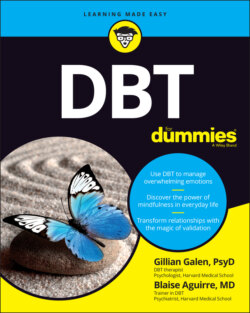Читать книгу DBT For Dummies - Gillian Galen - Страница 59
Finding your emotional balance
ОглавлениеExperiencing stressful situations and having no time to unwind can lead to psychological distress. The thought of dealing with life’s stress can feel impossible, and many people choose to ignore or avoid dealing with problems that come along. DBT teaches that avoidance of dealing with stress can lead to more stress, and so rather than avoiding the stress, finding emotional balance is a way to manage these situations.
But what is emotional balance and how do you achieve it? Typically, when in the heat of an unwanted situation, most of us react with strong emotions — typically anger, fear, anxiety, worry, or sadness. Having emotional balance is the practice of balancing these unwanted emotions using effective ways of dealing with them so that you don’t end up stuck in them or spend your time ruminating about how terrible and unfair life is. Finding this balance is also a way to increase happiness, improve motivation to do things differently, and help you get a good night’s rest.
Specific steps can help you practice, build, and maintain emotional balance. SUN, WAVE, and NO NOT are ways to do this, as you find out in the following sections. You can also practice gratitude and use behavioral activation.
In finding balance, you can use emotion regulation skills (see Chapter 10) along with distress tolerance skills (see Chapter 11). When you use emotion regulation skills, you focus on dealing with difficult emotions without acting on behaviors that might have adverse consequences. On the other hand, distress tolerance skills are used for the tolerance and momentary acceptance of difficult situations without making the situations worse. Using all of these ideas on a regular basis is the DBT way to find emotional balance.
